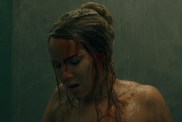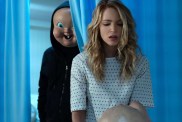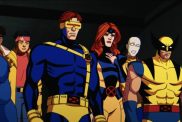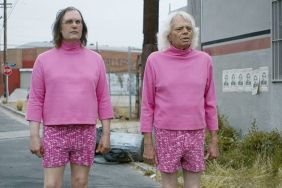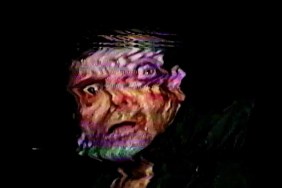Coming soon!

Cast:
Jayce Bartok as Andy
Amelia Cooke as Nina
Richard Ian Cox as Doug
Rob deLeeuw as Ben
Henry Gibson as Tour Guide
Lara Harris as Julia
Scott Heindl as Zack
Scott Lowell as Henry
Luke MacFarlane as Vincent
Directed by Joe Dante, John Gaeta, Sean Cunningham, Monte Hellman, Ken Russell
Review:
Thereâs something about the anthology paradigm that simply makes them difficult to pull off. The strongest entries in this sub-genre, it seems, are usually the ones which have a compelling spine or wrap-around story on which the vignettes can securely rely on for support, like 1972’s “Asylum.” Written by Robert (“Psycho”) Bloch, the primary story concerns a psychiatrist who, as part of a job interview to work for a famous colleague whom he’s never met, must interview four patients in the asylum to determine who among them is actually the doctor him or herself. And as each patient relays their macabre story as to how they managed to find themselves in the asylum, the viewing experience actually becomes interactive as we find ourselves in the shoes of the young psychiatrist trying to figure out which patient is actually the doctor. And for those who have never seen this Amicus classic (shame on you) I’ll not spoil it for you.
In more recent years, the horror anthology has had to live in the shadow of “Creepshow,” the 1983 George A. Romero and Stephen King homage to the horror comics of William Gaines. And, again, the pic had a solid wrap-around story supporting the five cinematic shorts. Who among us didn’t identify with the young lad catching hell from his parents after getting caught reading that “Sick, twisted crap! All that horror crap!”
Unfortunately, the cinematic wasteland is littered with the corpses of the failed attempts at a horror anthology. Stephen King himself failed to recapture lightning in a bottle with the ill-conceived 1985 “Cat’s Eye,” based on short stories from his “Nigh Shift” collection. Ditto for Romero who, in 1990, teamed with Dario Argento on the cinematic love letter to Edgar Alan Poe, “Two Evil Eyes.” That same year, also saw the feature adaptation of the popular show “Tales From The Darkside” met with a collective yawn. Yes, anthologies are indeed difficult to pull off.
Which brings us to “Trapped Ashes.” Written by Dennis Bartok (former Head of Programming for the American Cinematheque in Los Angeles) pic uses the multiple director method (ala “Twilight Zone: The Movie”) assembling what, on paper, looks like an solid team of genre directors; Joe (“The Howling”) Dante, Ken (“Gothic”) Russell, Sean (“Friday The 13th) Cunningham, Monte (“Two Lane Blacktop”) Hellman and first time director John Gaeta who’s previous experience was serving as Visual Effects Supervisor on “The Matrix” films, “Judge Dredd” and “Star Trek V.”
The all important wrap-around story (directed by Joe Dante) centers on six people who have been invited on a special tour of an old Hollywood studio back lot. Curiously, none of them seem to remember how they came by the tickets allowing them on this tour, but play along just the same. As the Tour Guide leads them through the deserted back lot, they come upon the “Hysteria House,” an obvious nod toward the “Psycho House” which can be seen on the Universal tour. However, this house has a history behind it. The director, it seems, disappeared after making his classic horror film amid rumors of orgies and satanic rituals on the film set. Despite cautionary words from the Tour Guide, the guests, of course, are determined to go inside the famous set to see it up close and personal. Upon doing so, they find themselves trapped inside and forced to tell personal, true horror stories in order to get out, just like in the “Hysteria” movie.
Thus begins our anthology. Over the course of the film we are told four stories which range from the bizarre, to the grotesque, to the curious and then, ultimately, the surreal. The first installment, “The Woman With The Golden Breasts,” a humorous account of breast augmentation gone terribly wrong starring Rachel (“American Pie 4”) Veltri and directed by Ken Russell, is the weakest of the lot and seems out of place given the tone of the rest of the film. While it contains some cringe inducing moments, it’s simply not very good and one has to wonder why it was included when it’s so far removed from the other stories which are all similar in tone. Not to mention putting it first misleads the viewer into thinking the rest of the film is apt to be more of the same, which, thankfully, it’s not.
The second entry, “Jibaku,” directed by Sean Cunningham, about a woman’s (Lara Harris) sexual seduction by a Japanese demon, is much better and shows Cunningham stretching his artistic legs. Mixing Japanese style porn animation with live action, it’s far removed from what we’ve seen from Cunningham in the past and it was nice to see the horror veteran expanding his horizons beyond the “Friday the 13th” type films we all associate him with. Serving primarily as a producer of the past couple decades, it’s been easy to forget Cunningham is actually a talented filmmaker. But, after viewing this segment, we’re not apt to forget it again. There are some genuine gross-out moments in this installment and those familiar with the “Hot Blood” and “Book of The Dead” anthologies will certainly have flashbacks.
The third vignette, directed by Monte Hellman, is an interesting entry. Like the works of novelist James Elroy, who takes real life events (such as the Kennedy assassination in “American Tabloid”) and weaves fiction throughout the historical facts, writer Dennis Bartok seems to create a fictional (or is it?) story as to why director Stanley Kubrick left America to never return. Titled “Stanley’s Girlfriend,” the story centers on two up and coming filmmakers in 1950s Hollywood, one of them named Leo (Tahmoh “Battlestar Galactica” Penikett playing a young John Saxon who tells the story) and the other named Stanley (Tygh “Snakes on A Plane” Runyan). The two meet by chance, become fast friends and begin spending an inordinate amount of time together just about every day. That is, until, Stanley hooks up with Nina (the smoldering Amelia “Species III” Cooke). It’s not long before Stanley is spending every waking minute with this voluptuous siren; never returning calls, never leaving his home and never going to work. Until, one day, Stanley suddenly flees to Europe sending only a note indicating he never intends to return, leaving Leo to wonder why. Is something afoot? Has it something to do with Nina, whom he is drawn to like a moth to a flame? A flame he can’t seem to resist touching? While Bartok certainly never uses the last name of Kubrick in relation to the Stanley character, the comparisons are quite obvious to anyone even remotely familiar with Kubrick’s life. It also shows Bartok’s range as a writer as this if far from your typical horror anthology story, but it is certainly one of this film’s better installments.
The final entry, “My Twin, The Worm,” is, by far, the strongest. Directed by John Gaeta, the story tells the tale of how the character Natalie (Michele-Barbara “Eyes of Terror” Pelletier) grew in her mother’s womb alongside a tape worm which had taken up residence in her mother’s stomach after consuming under cooked meat. Playing out like a poetic dream, Natalie waxes about her emotional conflicts concerning the worm; seeing it both as a companion in such a dark and desolate place, but also as competition, the worm stealing food and nourishment meant for her. Gaeta shows a strong visual style in his first outing in the director’s chair as the segment truly does unspool like visual poetry and it’s a shame the film doesn’t end right here. Unfortunately, we are forced to return to the wrap around story which, in comparison to the final three vignettes, comes off like a first year film student’s year-end final.
Joe Dante’s lackluster directorial style, which we’ve all endured for the past two seasons on the Showtime series “Masters of Horror,” is on full display here and there’s virtually nothing positive to say about it. In his defense, however, the premise isn’t really that strong to begin with and while it’s clear writer Dennis Bartok has a passion for all things old school Hollywood (three of the entries, including the back story, are Hollywood themed) some of it is rather insider and while this reviewer enjoyed the winks, nods and hat tipping to the industry’s bygone era, it may not appeal to most.
Despite the flawed wrap-around story, the strength of the final three entries is more than enough to recommend this movie. Horror fans looking for plenty of grue, ala “Masters of Horror,” should be happy with the first two installments, but the strength of this film isn’t in its graphic display of wanton gore, but in its restraint and use of good old fashioned story telling complete with characterization and a sense of wonder. Which is something we, sadly, don’t see too often these days.

